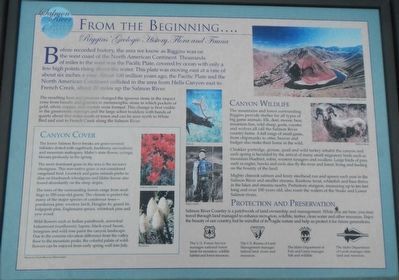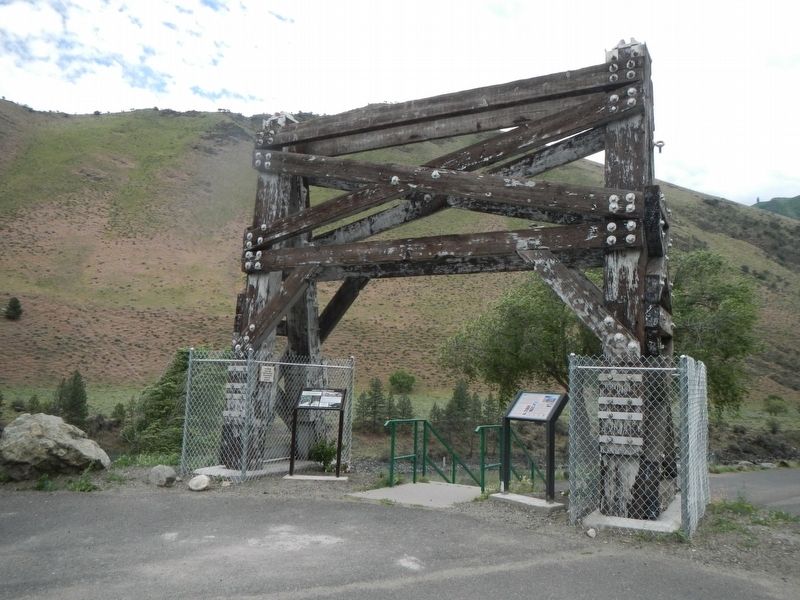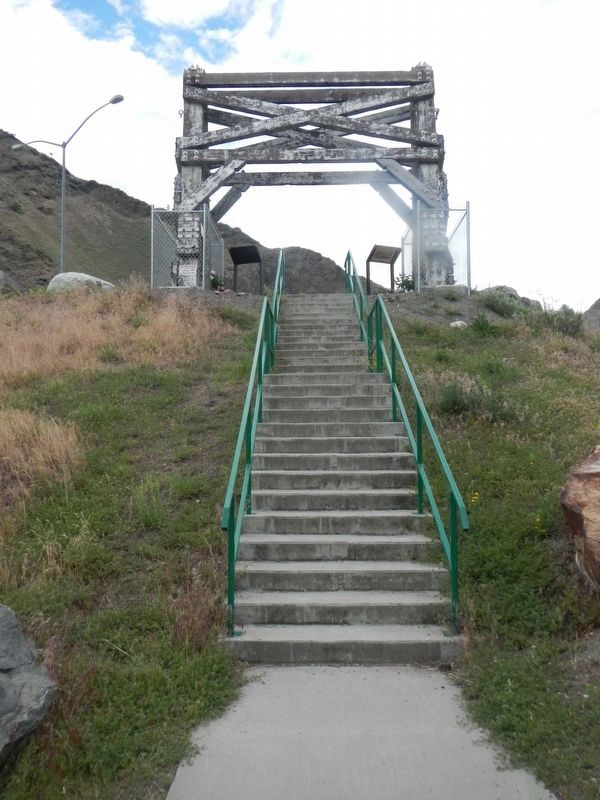Riggins in Idaho County, Idaho — The American West (Mountains)
From The Beginning
Riggins’ Geologic History, Flora and Fauna
— Salmon River Heritage Waking Tour —
Inscription.
Before recorded history, the area we know as Riggins was on the west coast of the North American Continent. Thousands of miles to the west was the Pacific Plate, covered by ocean with only a few high points rising above the water. This plate was moving east at a rate of about six inches a year. About 100 million years ago, the Pacific Plate and the North American Continent collided in the area from Hells Canyon east to French Creek, about 20 miles up the Salmon River.
The resulting heat and pressure changed the igneous stone in the impact zone from basalts and granites to metamorphic stone in which pockets of gold, silver, copper, and crystals were formed. This change is first visible in the greenstone outcrops and the large schist boulders with bands of quartz about five miles south of town and can be seen north to White Bird and east to French Creek along the Salmon River.
Canyon Cover
The lower Salmon River breaks are grass-covered, hillsides dotted with sagebrush, hackberry, serviceberry and mountain mahogany. Idaho's state flower, syringa, blooms profusely in spring.
The most dominant grass in the area is the invasive cheatgrass. This non-native grass is considered rangeland feed. Livestock and game animals prefer to dine on bluebunch wheatgrass and Idaho fescue also found abundantly on the steep slopes
The trees of the surrounding forests range from seedlings to 350-year-old giants. The climate is perfect for many of the major species of coniferous trees - ponderosa pine, Englemann spruce, white bark pine and yew wood.
Wild flowers such as Indian paintbrush, arrow leaf balsam root (sunflower), lupine, black-eyed Susan, beargrass and wild rose paint the canyon landscape. Due to the extreme elevation difference from the valley floor to the mountain peaks, the colorful palate of wildflowers can be enjoyed from early spring well into July.
Canyon Wildlife
The mountains and forests surrounding Riggins provide shelter for all types of big game animals. Elk, deer, moose, bear, mountain lion, wild sheep, goats, coyotes and wolves all call the Salmon River country home. A full range of small game, from chipmunks to otter, beaver and badger also make their home in the wild.
Chukkar partridge, grouse, quail and wild turkey inhabit the canyon and each spring is heralded by the arrival of many small migratory birds such as mountain bluebirds, robin, western tanagers, and swallow. Large birds of prey such as eagles, hawks, and owls also fly the river and forest, living and feeding on the bounty of the land.
Mighty chinook salmon and feisty steelhead run and spawn each year in the Salmon River and smaller streams. Rainbow trout,
whitefish and bass thrive in the lakes and streams nearby. Prehistoric sturgeon, measuring up to ten feet long and over 100 years old, also roam the waters of the Snake and Lower Salmon rivers.
Protection and Preservation
Salmon River Country is a patchwork of land ownership and management. While you are here, you may travel through land managed to enhance recreation, wildlife, timber, clean water and other resources. Enjoy the beauty of our country, but be mindful of its fragile nature and help us protect it for future generations.
Erected by City of Riggins.
Topics. This historical marker is listed in this topic list: Natural Features.
Location. 45° 25.472′ N, 116° 18.775′ W. Marker is in Riggins, Idaho, in Idaho County. Marker can be reached from North Main Street (U.S. 95) near North Dixon Street, on the right when traveling north. Touch for map. Marker is at or near this postal address: 327 North Main Street, Riggins ID 83549, United States of America. Touch for directions.
Other nearby markers. At least 8 other markers are within walking distance of this marker. Manning Crevice Bridge (here, next to this marker); The Scow (here, next to this marker); Riggins Area Honor Roll (within shouting distance of this marker); Keeping the Faith (about 400 feet away, measured in a direct line); Entrepreneur J.J. Goff
(about 600 feet away); Educating Riggins' Children (about 700 feet away); Early Businesses (approx. 0.2 miles away); Riggins in the 1940s (approx. 0.2 miles away). Touch for a list and map of all markers in Riggins.
Credits. This page was last revised on June 28, 2018. It was originally submitted on June 28, 2018, by Barry Swackhamer of Brentwood, California. This page has been viewed 215 times since then and 24 times this year. Photos: 1, 2, 3. submitted on June 28, 2018, by Barry Swackhamer of Brentwood, California.


